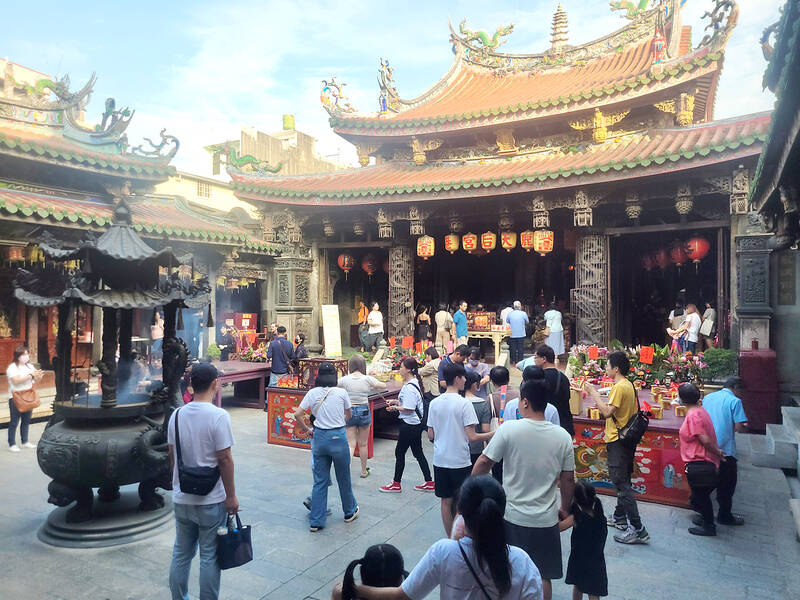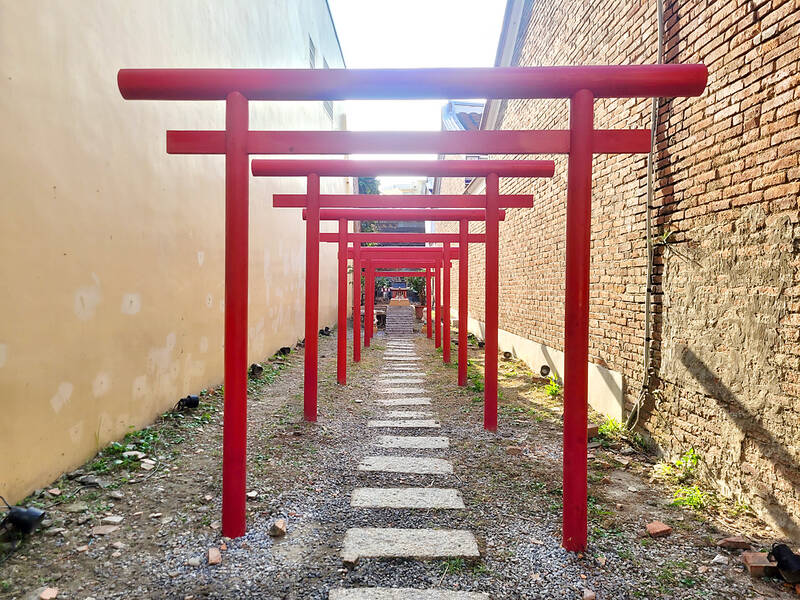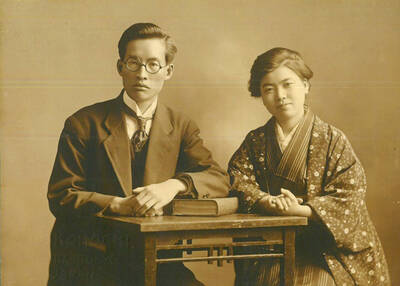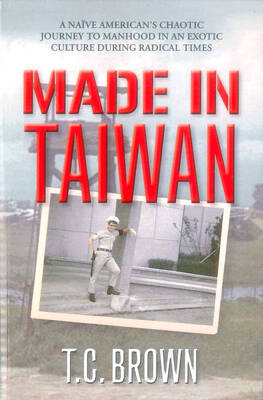In the tourism desert that is most of Changhua County, at least one place stands out as a remarkable exception: one of Taiwan’s earliest Han Chinese settlements, Lukang. Packed with temples and restored buildings showcasing different eras in Taiwan’s settlement history, the downtown area is best explored on foot. As you make your way through winding narrow alleys where even Taiwanese scooters seldom pass, you are sure to come across surprise after surprise.
The old Taisugar railway station is a good jumping-off point for a walking tour of downtown Lukang. Though the interior is not open to the public, the exterior is remarkably well maintained and — along with the abandoned sugarcane locomotive nearby — serves as a reminder of the Japanese industrialization of Taiwan. For anyone who comes to Lukang by car, there is also a large parking lot here. If you’re using public transit, there is a bus stop right in front of the station.
What follows is a suggested route for a leisurely 3.5km afternoon walk. You can follow along with the online map, but there’s no need to stick strictly to this route. Part of the fun of such a walk is in exploring unknown alleys, and going wherever your ears, eyes, and nose lead you. There are surely many important places missing from this itinerary, but such is the nature of trying to draw a single line through a city so packed with interesting sights.

Photo: Tyler Cottenie
TRADITIONAL ARCHITECTURE
From the Taisugar railway station, head to Sanmin Road (三民路) and then west to the beautiful Longshan Temple complex (鹿港龍山寺). To step into the first courtyard is to step out of the chaos of the modern world and into a more serene, orderly space that harkens back to the early days of Han settlement in Lukang. In fact, a temple has stood here since 1786, though the current structures are the end result of no fewer than five major reconstructions or renovations, four of which were carried out after earthquake damage.
The centuries-old banyan trees and pleasingly symmetrical facades and roofs with their classic flying eaves and dragon decorations certainly make the Longshan Temple worth a visit, as do the intricate wooden carvings in the porticos and smoke-tinted door god paintings. However, the highlight of the visit — at least for a non-believer — may be the meditative garden at the very back. Koi swim under a bridge spanning a pond flanked by two brick buildings, as turtles sun themselves on little islands in the pond, all set against the backdrop of a waterfall and artfully manicured trees.

Photo: Tyler Cottenie
Leave the temple via the alley to the north of the entrance plaza and make your way north and east, following the red brick pavement. Just before reaching Jhongshan Road (中山路), you will pass the Yilou building (鹿港意樓), a photogenic 200-year-old home purchased and restored with private funds. Take note of the gorgeous star fruit tree poking its head over the brick wall near the back: legend has it, this was planted by a man as a reminder of himself for his wife, just before he headed out on business, only to never return.
A MAZE OF ALLEYS
By now, you’ll have reached Jhongshan Road. Look for the Ting Family Historical Residence (鹿港丁家古厝), numbers 130, 132 and 134 on the opposite side of the road. The Tings were successful merchants in 19th century Lukang and this building has been renovated and opened to businesses and the general public. After walking through the shops, walk further in to reach the gorgeous courtyards, painted in subdued reds and blues and accented by painted reliefs.

Photo: Tyler Cottenie
Continuing out the back of the Ting Family Residence puts you right at the entrance to the Lukang Folk Arts Museum, an absolute must-see, if only from the gate. The immaculate building and grounds are one of the best examples of colonial-era architecture in the country. Whereas many of the so-called “Western mansions” built by wealthy families of the early 20th century now lie in a semi-ruined state, this one looks as if construction was just finished last year. If you have the time, spend an hour walking the grounds and exploring the museum exhibits inside, which present a succinct yet rich overview of the cultural heritage of Lukang’s Han settlers.
Next, continue weaving your way counterclockwise around the museum grounds through more scenic alleys (and dead ends), making your way back to Jhongshan Road and the Ting residence’s front entrance. Cross the road onto Sinsheng Street (新盛街) and take the first right turn back onto the familiar red-brick pavement. This winding lane, Jiuqu Lane (“Nine Turns Lane” 九曲巷), passes by an interesting array of homes of varying degrees of modernity and decay.
The brick pavement ends at Liulutou (“where six roads start” 六路頭). I was unable to find a sixth road, but there are certainly still five roads that come together at this point, including the old ox cart trail leaving the city for southern Changhua (look for the brick archway with a blue top). Follow the old ox cart trail for a while if you like, then make your way north to Daming Road (大明路) and turn right to reach a bunch of restaurants and food vendors.

Photo: Tyler Cottenie
FOOD AND CROWDS
This would be a great place to sample one of Taiwan’s local dishes, the meatball dumpling (肉圓), which originated in Changhua. If you’re not yet hungry, don’t worry; there will be plenty more food stalls to come very soon. Follow Daming Road to its end and turn left at the Family Mart onto yet another alley paved in red brick. Just a minute up the road on the left, there is a modern curiosity: a long row of red torii gates set in an empty lot between two buildings leading toward a tiny Shinto shrine. Right next door is yet another beautifully restored property combining traditional Fujianese and Western elements in its architecture, the Heci Villa (鹿港鶴棲別墅). This once served as both a residence and a business headquarters, but nowadays serves as an art gallery.
Once you get to the next major intersection, turn left onto Minquan Road (民權路), and walk to the next red brick alley on your right — the one with hundreds of people in it. This is Lukang’s “Old Street” where you can buy souvenirs, or fill up on local delicacies and standard night market food. After eating your way down the street, turn right and then left to reach Lukang’s most famous temple and the end of the walking tour: the Lukang Mazu Temple (鹿港天后宮).

Photo: Tyler Cottenie
The temple is one of the oldest and most important sites of Mazu worship in Taiwan, and its present site will be 400 years old next year. Just as ornate as Longshan Temple at the beginning of the walk, the Mazu Temple is, however, much less serene. It lacks the manicured garden and is much louder, both visually and aurally. A large number of worshippers visit every day, and it’s normal to see throngs of people milling about the entrance after worship, grabbing a bite from one of the food vendors nearby. If you’re looking for a bustling temple atmosphere, this is the place.
Leaving the crowds behind, make your way north and east toward the Lukang Stadium. On the east side of the stadium is a bus stop with the most convenient connections back to Changhua train station, or back to your car at the Taisugar railway station.
PUBLIC TRANSIT

Photo: Tyler Cottenie
From Taichung High Speed Rail: Take Bus 6936A to the Fusing Township Farmers Association stop and walk a few minutes to the Taiwan Sugar Train Station. Return by Bus 6933 from the Lugang Township Office stop.
From the Changhua railway station: Take Bus 6900, 6933 or 6934 to the Taiwan Sugar Train Station stop. Return by Bus 6901 from Lukang Station stop next to the stadium or Bus 6902 from the Theater stop (last return bus around 5pm). For a later return, take Bus 6933 mentioned above toward Taichung HSR around 8pm, but get off at the Changhua train station.

Aug. 25 to Aug. 31 Although Mr. Lin (林) had been married to his Japanese wife for a decade, their union was never legally recognized — and even their daughter was officially deemed illegitimate. During the first half of Japanese rule in Taiwan, only marriages between Japanese men and Taiwanese women were valid, unless the Taiwanese husband formally joined a Japanese household. In 1920, Lin took his frustrations directly to the Ministry of Home Affairs: “Since Japan took possession of Taiwan, we have obeyed the government’s directives and committed ourselves to breaking old Qing-era customs. Yet ... our marriages remain unrecognized,

During the Metal Ages, prior to the arrival of the Dutch and Chinese, a great shift took place in indigenous material culture. Glass and agate beads, introduced after 400BC, completely replaced Taiwanese nephrite (jade) as the ornamental materials of choice, anthropologist Liu Jiun-Yu (劉俊昱) of the University of Washington wrote in a 2023 article. He added of the island’s modern indigenous peoples: “They are the descendants of prehistoric Formosans but have no nephrite-using cultures.” Moderns squint at that dynamic era of trade and cultural change through the mutually supporting lenses of later settler-colonialism and imperial power, which treated the indigenous as

An attempt to promote friendship between Japan and countries in Africa has transformed into a xenophobic row about migration after inaccurate media reports suggested the scheme would lead to a “flood of immigrants.” The controversy erupted after the Japan International Cooperation Agency, or JICA, said this month it had designated four Japanese cities as “Africa hometowns” for partner countries in Africa: Mozambique, Nigeria, Ghana and Tanzania. The program, announced at the end of an international conference on African development in Yokohama, will involve personnel exchanges and events to foster closer ties between the four regional Japanese cities — Imabari, Kisarazu, Sanjo and

By 1971, heroin and opium use among US troops fighting in Vietnam had reached epidemic proportions, with 42 percent of American servicemen saying they’d tried opioids at least once and around 20 percent claiming some level of addiction, according to the US Department of Defense. Though heroin use by US troops has been little discussed in the context of Taiwan, these and other drugs — produced in part by rogue Chinese Nationalist Party (KMT) armies then in Thailand and Myanmar — also spread to US military bases on the island, where soldiers were often stoned or high. American military policeman